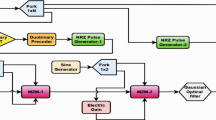Abstract
Bidirectional Cable TV networks using hybrid fiber coaxial (HFC) systems are good examples of broadcast environments where a contention resolution algorithm is needed in order to allocate the multiaccess medium among various customers. The medium access control (MAC) scheme, proposed by DAVIC/DVB, IEEE 802.14 and DOCSIS for the upstream channel of HFC access networks is based on a mixable contention-based/contentionless time slot assignment. Contention-less (CL) slots are assigned by the head-end (HE) to end stations according to a reservation scheme. Contention-based slots (CB) are randomly accessed by active terminals without any prelimanry allocation and so collisions may occur. To resolve contention the contention tree algorithm has been widely accepted by the DVB/DAVIC, IEEE 802.14 and DOCSIS standards for MAC because of higher throughput and lower access delay. In this paper we propose a simple modification to the existing protocol and analyze its performance. We propose to have one slot in the frame exclusively reserved for the new arrivals that wish to access the channel capacity using contention resolution and atleast one more slot reserved for resolving their contention if there was a contention in the arrival slot. This assumption simplifies the protocol to a queuing mechanism and we use the results of the queue to analyze the protocol. The queuing analysis method is used to determine the throughput of the channel and waiting times of the arbitrary customers. Furthermore, we present numerical results and compare that with simulations.
Similar content being viewed by others
REFERENCES
Abramson, N., “The ALOHA System-Another Alternative for Computer Communications”, “Proc. 1970 Full Joint Comp. Conf. AFIPS”, Vol. 37, 1970.
Berger, T, “The Poisson multiple-access conflict resolution problem”, in G. Longo (ed.), Multi-user Communication Systems, CISM course and Lecture Notes 265, Springer Verlag, New York, 1981, pp. 1–27.
Bisdikian, C. “A Review of Random Access Algorithms”, Proc. Intl. Workshop on Mobile Commun., Thessaloniki, Greece, Sept. 1996, pp. 123–127.
Capetanakis, J. I., “Tree Algorithms for Packet Broadcast Channels”, IEEE Trans. Info. Theory, 25, 505–515 (1979).
DAVIC 1.3 Specifications: Part 8 — Lower Layer Protocols and Physical Interfaces, Revision 6.2.
DVB, Digital Video Broadcasting (DVB); DVB interaction channel for Cable-TV distribution systems (CATV), working draft (version 2), March 12, 1999, based on European Telecommunications Standard.
Gallager, R. G. “A perspective on multiple access channels”, IEEE Trans. Inform. Theory, 31, 124–142 (1985).
Hajek, B., N. B. Likhanov and B. S. Tsybakov, “On the delay in a multiple-access system with large propagation delay”, IEEE Trans. Inform. Theory, 40, 1158–1166 (1994).
IEEE 802.14 WG, Cable-TV access method and physical layer specification, Draft 3, Revision 3, Oct. 1998.
Janssen A. J. E. M. and M. J. M. de Jong, “Analysis of Contention Tree-Algorithms”, IEEE Trans. Info. Theory, 46, 6, (2000).
Kleinrock, L. and F. A. Tobagi, “Packet Switching in Radio Channels: Part 1: CSMA modes and their Throughput-Delay Characteristics”, IEEE Trans. Commun., 23, 1400–1416 (1975).
Massey, J. L. “Collision resolution algorithms and random access algorithms”, in G. Longo (ed.), Multi-user Communication Systems, CISM course and Lecture Notes 265, Springer Verlag, New York, 1981, pp. 73–131.
MCNS Holdings, Data-Over-Cable Service Interface Specifications, Radio Frequency Interface Specification, Ref. Nr. SP-RFIv1.1-PI01-990226 (Feb. 1999).
Ruget, G. “Some tools for the study of channel sharing algorithms”, in G. Longo (ed.), Multi-user Communication Systems, CISM course and Lecture Notes 265, Springer Verlag, New York, 1981, pp. 201–231.
Sai Shankar, N. “A Distributed Queueing Model for Contention Resolution Protocol in HFC Access Networks”, Proc. of Int. Conf. Inf. Comm. and Sig. Proc., Singapore, Oct. 2001.
Tsybakov, B. S. and V. A. Mikhailov, “Free Synchronous Packet Access in a Broadcast Channel with Feedback”, Probl. Info. Trans., 14, 259–280 (1978).
van den Broek, M.X. “On contention resolution procedures — queueing analysis and simulation”, Master's Thesis, Eindhoven University of Technology, Eindhoven, The Netherlands, 2001.
Author information
Authors and Affiliations
Rights and permissions
About this article
Cite this article
Shankar, N.S. A New Contention Resolution Procedure for HFC Access Networks and its Performance Evaluation. Journal of Scheduling 7, 149–167 (2004). https://doi.org/10.1023/B:JOSH.0000014070.79482.f7
Issue Date:
DOI: https://doi.org/10.1023/B:JOSH.0000014070.79482.f7




